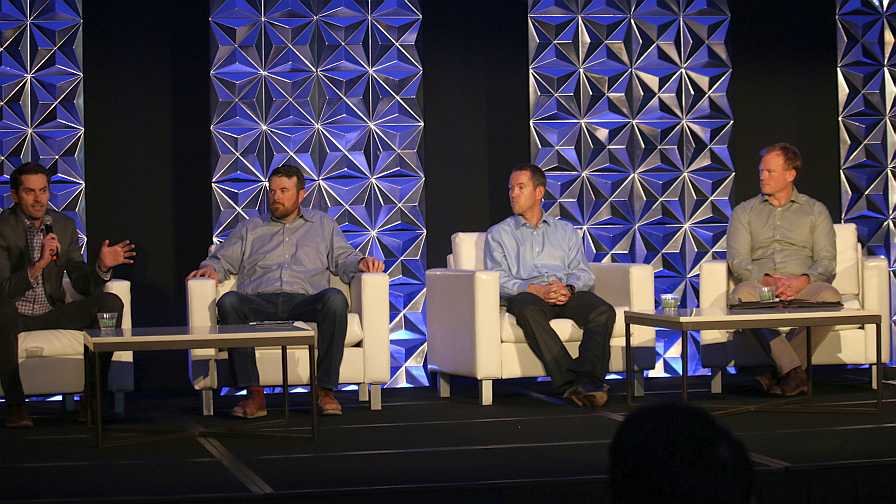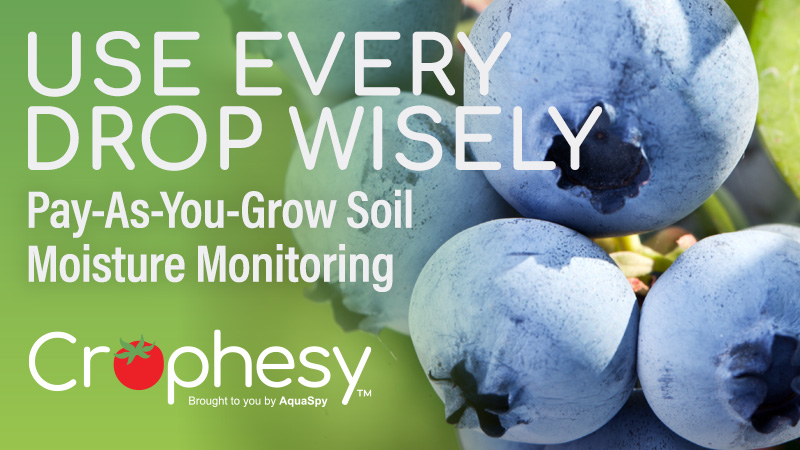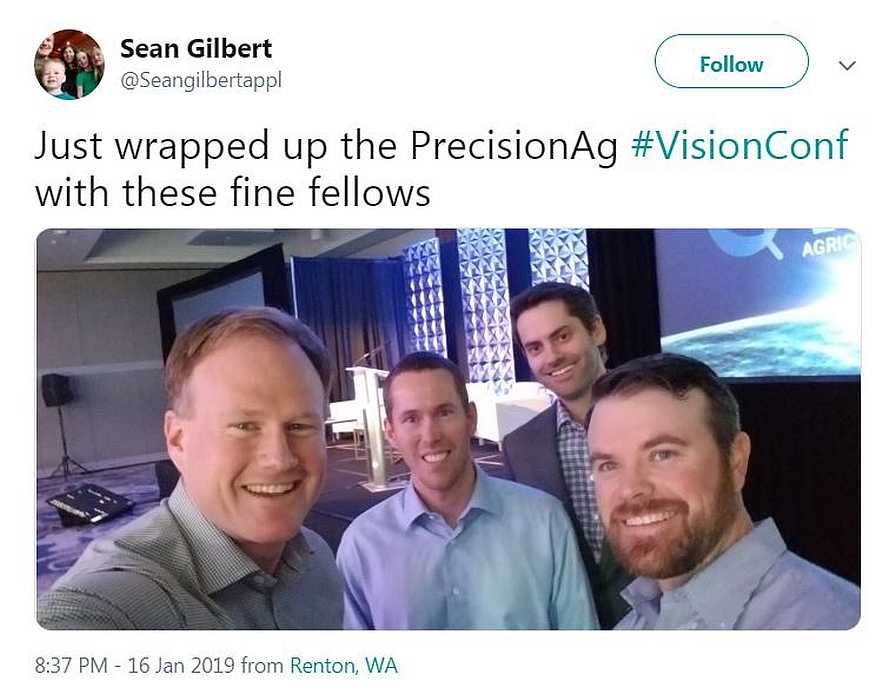Top Growers Ground-Truth Promise of Precision Agriculture

[From left] Patrick Smith, B. T. Loftus Ranches Inc.; Danny Royer, Agriculture Executive Consultant; Dan Plath, Washington Fruit and Produce Co.; and Sean Gilbert of Gilbert Orchards participated in a “fireside chat” during the 2019 PrecisionAg VISION Conference in Seattle to discuss ag tech trends in specialty crops. Photo by Robin Siktberg
The two-day conference, presented and hosted by Meister Media Worldwide and its Global Precision Initiative, wound down with a fireside chat moderated by American Fruit Grower/Western Fruit Grower Editor David Eddy that featured four “executive growers”: Patrick Smith, Vice President, B. T. Loftus Ranches Inc., Yakima, WA; Danny Royer, Agriculture Executive Consultant, California’s Central Valley; Dan Plath, Vice President, Washington Fruit and Produce Co., Yakima; and Sean Gilbert, President, Gilbert Orchards, Yakima.
Here’s what they discussed.
Adoption in specialty crops. “I always thought specialty crop growers have more money to invest” than do row crop growers, Smith said. But the wide range and smaller scale of specialty crop operations and disparities of regions and growing systems are probably daunting for many suppliers, the growers suggested, especially when compared with row crop farms that collectively have more production scale and uniformity among them.
Robotics and automation. Plath said his operation hasn’t needed robotics yet but “investment is going that way. We’ll see more of this in the not-too-distant future.” Gilbert noted that the trend to high-density apple orchards grown on trellises results in “wall of fruit” production that is ready-made for robotics, while Royer said additional efforts in genetics “will need to be developed to make these changes happen.”
Plath said growers don’t necessarily need autonomous equipment — “we already have equipment moving through the fields” — but that if a reliable sensing technology can give him a better sense of what’s happening in the field, “I’d buy that sensor tomorrow.”
 Precision irrigation. Royer predicted urbanization pressures and regulations regarding access to water in the West are only going to increase, and that states like California have “a long way to go in terms of infrastructure.” Growers, he said, will have to “get educated” and look to other areas of the world like the Netherlands and Israel where more precise application of water already has been adopted.
Precision irrigation. Royer predicted urbanization pressures and regulations regarding access to water in the West are only going to increase, and that states like California have “a long way to go in terms of infrastructure.” Growers, he said, will have to “get educated” and look to other areas of the world like the Netherlands and Israel where more precise application of water already has been adopted.
Plath said his staff still needs to confirm precision irrigation activity with “boots on the ground and a shovel” and noted the positioning of drip irrigation emitters is very important. Smith said his operation needs “more sensors in increased magnitudes” — although of course the high cost of such sophisticated devices still is an impediment. Royer suggested something as simple as a pressure switch might be an inexpensive way to validate that water was turned on.
Data management. The growers agreed there is plenty of room for improvement in increasing a crop’s value based on its characteristics — apple size and color, for instance. Also crop load — Plath said workers currently roam 20,000-tree blocks counting apples per tree using pencil and paper, and that’s a huge opportunity for technology providers.
Smith referenced the “four stages of analytics”: determining what happened, explaining why it happened, predicting what is going to happen, and solving the problem. “Most farms are still at stage one,” he said. He envisions a day of predictive analytics when a grower will receive an email essentially saying– “here are the top 10 things you can do today to improve your yield six months from now.”
“What we’re doing is not Monte Carlo,” Smith said. “Things are happening for a reason.” Data, he says, “can better influence that outcome. The more we can connect the dots, the more we can influence what’s going on in the field.” However, he called on more suppliers to use more open-source coding, APIs, etc. to help growers “unlock that information. This is something we really struggle with. Data is unique to my operation. I need to get it in a useable state.”
What does ag tech need to understand? “That it all starts with the orchard,” Royer said without hesitation. Providers of technology need to have a clear sense of how their product or service fits into the orchard.
Plath said precision tools are used unequally across his company’s growing locations for a simple reason: “You have to have farm management buying in.” He said there can be as many as 50-100 personnel involved in a decision to adopt a technology, meaning pushback can come from a wide group of people. Aerial imagery, for instance, is not an obvious solution for everyone. “We know we have problems in the field,” he said. “We just don’t always know how to fix them.”
Gilbert noted the importance of field durability. Micro-spraying, for example, “looks great,” but the equipment “also looks fragile for our operation” with its challenging hills and terrain.
Smith said he takes issue with suppliers who “come in with a silver bullet, who promise ‘quantum leaps in efficiency.’ Claims like that put me off.” He suggested technology providers “do one thing really, really well. Don’t try to shoot for the moon right away.”
Royer said a large number of suppliers talk about cutting costs when they really should focus on “improving the value of what the grower produces at the farmgate.” He suggested suppliers should talk more with growers and “close the feedback loop.”
What most struck them at the conference. The event covered a wide assortment of issues across two full days and included a pre-conference half-day visit to Microsoft, where “Project FarmBeats” personnel previewed plans for agriculture to be fully introduced later this year.
What was top of mind for these growers?
Gilbert said an observation made at the conference that “one size fits one” stayed with him. “Whenever we try a one-size-fits-all approach, we get frustrated,” he said.
Royer said adoption of technology is still an issue, but so is culture. “There’s not enough focus on people issues” — training of the workforce especially, or a system to do workforce development. “We still have a lot to do on the people side of ag tech,” he said.
Smith said he was very interested in a self-built broccoli harvester described by presenter Josh Ruiz of Church Brothers Farms, Salinas, CA. “It’s not fully automated but it’s a step in the right direction,” he said. Technology will make incremental progress, and he believes a lot of technology is still “15 to 20 years down the road.” Nonetheless, developments he heard about at the conference that “are crop-agnostic are very exciting to me.”











